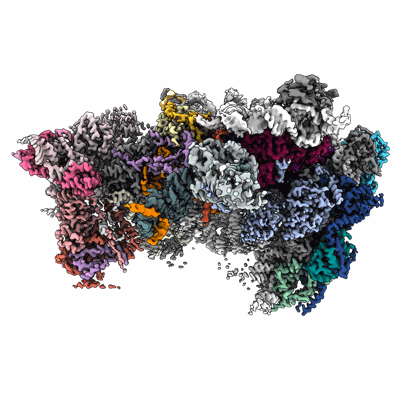EMD-29260
Human nucleolar pre-60S ribosomal subunit (State E) - Composite map
EMD-29260
Single-particle2.59 Å
 Deposition: 21/12/2022
Deposition: 21/12/2022Map released: 12/07/2023
Last modified: 19/07/2023
Sample Organism:
human
Sample: Human nucleolar pre-60S ribosomal subunit (State E)
Fitted models: 8fkx (Avg. Q-score: 0.535)
Raw data: EMPIAR-11472
Deposition Authors: Vanden Broeck A ,
Klinge S
,
Klinge S 
Sample: Human nucleolar pre-60S ribosomal subunit (State E)
Fitted models: 8fkx (Avg. Q-score: 0.535)
Raw data: EMPIAR-11472
Deposition Authors: Vanden Broeck A
 ,
Klinge S
,
Klinge S 
Principles of human pre-60 S biogenesis.
Abstract:
During the early stages of human large ribosomal subunit (60S) biogenesis, an ensemble of assembly factors establishes and fine-tunes the essential RNA functional centers of pre-60S particles by an unknown mechanism. Here, we report a series of cryo-electron microscopy structures of human nucleolar and nuclear pre-60S assembly intermediates at resolutions of 2.5 to 3.2 angstroms. These structures show how protein interaction hubs tether assembly factor complexes to nucleolar particles and how guanosine triphosphatases and adenosine triphosphatase couple irreversible nucleotide hydrolysis steps to the installation of functional centers. Nuclear stages highlight how a conserved RNA-processing complex, the rixosome, couples large-scale RNA conformational changes with pre-ribosomal RNA processing by the RNA degradation machinery. Our ensemble of human pre-60S particles provides a rich foundation with which to elucidate the molecular principles of ribosome formation.
During the early stages of human large ribosomal subunit (60S) biogenesis, an ensemble of assembly factors establishes and fine-tunes the essential RNA functional centers of pre-60S particles by an unknown mechanism. Here, we report a series of cryo-electron microscopy structures of human nucleolar and nuclear pre-60S assembly intermediates at resolutions of 2.5 to 3.2 angstroms. These structures show how protein interaction hubs tether assembly factor complexes to nucleolar particles and how guanosine triphosphatases and adenosine triphosphatase couple irreversible nucleotide hydrolysis steps to the installation of functional centers. Nuclear stages highlight how a conserved RNA-processing complex, the rixosome, couples large-scale RNA conformational changes with pre-ribosomal RNA processing by the RNA degradation machinery. Our ensemble of human pre-60S particles provides a rich foundation with which to elucidate the molecular principles of ribosome formation.
